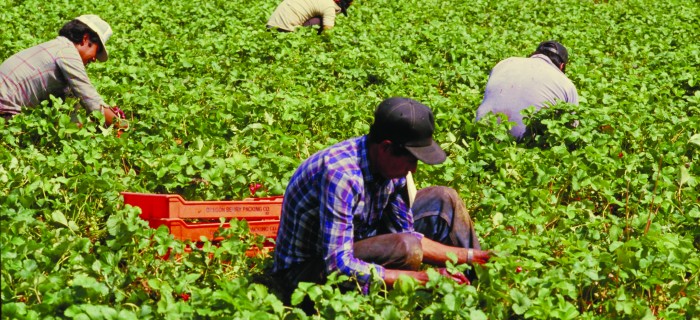Migrant Farmworkers: America’s New Plantation Workers?
In celebration of our 40th anniversary year, Food First is revisiting past publications from our rich archive of analyses on the root causes of hunger and social movements fighting for the right to food around the world. We hope you enjoy (re-)reading these trail-blazing pieces, which remain highly relevant today.
In this Backgrounder from 2004, Food First researchers Christine Ahn, Melissa Moore, and Nick Parker expose the exploitation and inhumane treatment of migrant farmworkers in the United States. Poverty, and the exploitation of those in poverty, lies at the root of the broken food and immigration systems. Corporate monopolies and international trade agreements have created or exacerbated poverty, causing a situation in which migrant farmworkers struggle to make a few thousand dollars per year, while major food producers and distributors post billions of dollars in profit.
In June 2003, Artimo and his brother, Mario, crammed into the back seat of a car driven by immigrant smugglers known as coyotes. They were on their way to Washington to pick apples and cherries. Throughout their journey across the mountainous terrain from Tijuana to San Diego, they were forced to crouch down to avoid being seen. When sirens began to wail, the driver sped up, lost control, and collided into another car. Although Artimo suffered three broken ribs and other injuries, he was the only one to survive.
Thousands of migrants risk death and incarceration daily by crossing the US-Mexico border. In the blistering 115-degree Arizona May heat in 2001, 14 immigrants perished in the rugged desert days after smugglers abandoned them. In 2003, 17 immigrants, including a 5-year-old boy, died of dehydration in the back of an abandoned truck in Texas. Despite the danger, “illegal” migration rates jumped 25 percent last year, and deaths have risen since 1994. Approximately 99 people die annually from exposure to heat, cold, and dehydration, compared with an average of six deaths in 1994.
Why are so many thousands risking their lives to cross the border? This backgrounder explores how trends in food production and developments in government policy foster conditions that make US farmworkers ripe for exploitation.
The Plight of US Farmworkers
More than two million year-round and seasonal migrant farmworkers, including 100,000 children, work in the US. About two thirds are immigrants, of whom 80 percent are from Mexico. Just 14 percent of all farmworkers have full-time work.
Stay in the loop with Food First!
Get our independent analysis, research, and other publications you care about to your inbox for free!
Sign up today!Agricultural work is amongst the most dangerous occupations, with injuries and illness disabling farmworkers at a rate three times that of the general population. In California, the average death rate for farmworkers is five times that of workers in other industries. Approximately 300,000 farmworkers in the US are poisoned by pesticides annually.
Agricultural work is amongst the most dangerous occupations, with injuries and illness disabling farmworkers at a rate three times that of the general population.
Farmworkers are paid poverty wages in spite of these risks. Three out of four US farmworkers earn less than $10,000 annually, and three out of five families live below the federal poverty line. Living conditions are equally harsh as migrant housing commonly lacks plumbing and working appliances, and is often next to pesticide-treated fields. Farmworkers spend more than 30 percent of their income on this substandard housing.
Farmworkers seldom have health care, disability insurance, vacation, or a pension, and they rarely apply for welfare. In a 1997-98 study, only five percent of farmworkers reported having health insurance covered by their employers for non-worked-related injuries, 28 percent reported compensation for work-related illnesses, and only one percent of workers used Social Security or disability insurance. Just 13 percent of farmworker families receive Medicaid, 10 percent get Food Stamps, and 10 percent participate in the Women, Infants, and Children program.
The Systematic Exploitation of Farm Workers
The $28 billion US produce industry is 85 percent cultivated and harvested by hand, mostly through the backbreaking labor of our nation’s farmworkers. We assume that their poverty subsidizes lower prices for the food we eat; however, according to journalist Eric Schlosser, “Maintaining the current level of poverty among migrant farmworkers saves the average American household (just) $50 a year.”
While the average farmworker in the US earns $7,500 per year, Archer Daniels Midland, the world leader in producing soy meal, corn, wheat, and cocoa, reaped $1.7 billion in profits in 2003; its CEO, Allen G. Andreas, received over $2.9 million in compensation. Dole, the world’s largest producer of fresh fruit, vegetables and cut flowers generated $4.8 billion in revenues in 2003.
Challenging Government-Supported Slavery
The federal prosecution of six cases of involuntary servitude in Florida shocked an American public that believed slavery no longer existed here in the US. But slavery in the fields exists because of government policies and market forces that have created a global food system that systematically displaces small farmers and exploits workers.
Nationally, there are several dynamic farmworker movements challenging these exploitative practices of large agribusinesses and corporations. The Coalition of Immokalee Workers has organized a boycott against Taco Bell, the largest purchaser of tomatoes from Immokalee, Florida, demanding one penny more in the piece rate per pound, an increase that would almost double the workers’ pay. In North Carolina, the Farm Labor Organizing Committee (FLOC) has waged a boycott against Mt. Olive Pickle Company, demanding that farmworkers have the right to negotiate their working conditions with farmers and the company. And in California, the UFW recently launched a boycott of Gallo Winery, to demand that the family-run business provide healthcare benefits to its workers. Dolores Huerta of the UFW believes that there are very “strong foundations in place for farmworkers to be unionized nationally.”
Click here to read the full Backgrounder.


 Help Food First to continue growing an informed, transformative, and flourishing food movement.
Help Food First to continue growing an informed, transformative, and flourishing food movement.




